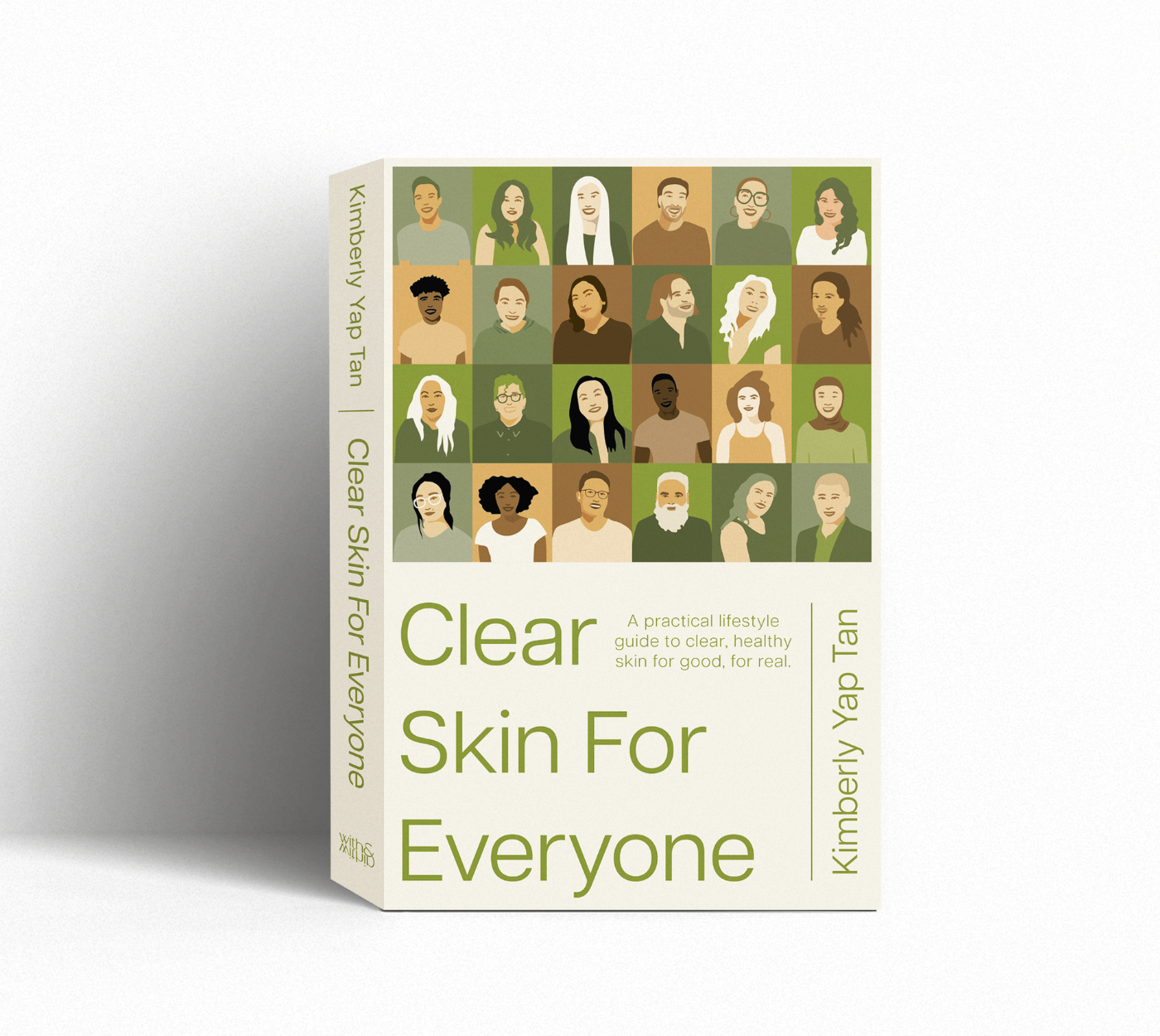
malassezia folliculitis, AKA "fungal" acne

"fungal" acne is a popular (and incorrect) term used to describe a skin condition that looks like acne, but actually isn't. when people talk about "fungal" acne, they are usually actually talking about malassezia follliculitis, or MF for short.
MF is a type of acneiform: acne-look-alike skin reactions that can look very similar to, but are not your typical acne vulgaris, which clears with the acne-safe lifestyle. acneiforms don't, because they're result of different factors like excess fungus or yeast on the skin or in the body, or are a reaction from medications. to make things a bit more confusing, both can exist on the skin at the same time - so it's best to be both acne- and MF-safe when shopping for skin products.
MF in particular seems to be influenced by excess fungal + yeast imbalances present either on the skin's surface or within the body. in the skin clinic, we've seen it on the face mostly around the mouth, nostril and nose areas, forehead and temples, and sometimes also on various part of the body (especially within folds of skin like under breasts, inner elbows and underarms). it also seemed to accompany almost every client we also suspected to have a candida albicans yeast overgrowth imbalance.
because it's so often misdiagnosed for and treated like acne vulgaris, it can persist for years until it's properly identified and treated. if you've been doing all the acne-safe things and just can't clear up (especially if you live in a humid climate), this may be the reason why.
HOW DO YOU KNOW YOU HAVE IT?
a big sign that what you're dealing with is malassezia folliculitis and not just regular acne is if it's itchy. regular acne vulgaris typically isn't itchy, but malassezia folliculitis, which is yeast- and fungus-related, often is. the rash can also have a flat patchy "plaque" type of appearance and texture, versus the more individual bumps that acne vulgaris usually appears as.
another big sign is if you are prone to yeast- or fungal-related infections, like vaginal yeast infections, jock itch, or athlete's foot. if you're getting infections somewhat regularly (or at all, really), get this checked out.
if these resonate, it might be best to consult an integrative therapist or holistic naturopathic doctor to help diagnose and support your body for the best results.
special thanks to our resident san francisco esthetician, kerry watson, for compiling most of the information below!
EDUCATIONAL RESOURCES
this fungal acne reddit group is a really great online support community for people who suspect they have fungal acne (or malassezia folliculitis). there is some good info here but since it's open to the general public to contribute, there's also some misinformation about skin and acne in general.
this article about drug induced follicular eruptions from dermnet new zealand takes a very allopathic conventional medicine approach to treatment which we at sS aren't really in alignment with, but the information regarding the cause and identification is useful.
folliculitis scout is an ingredient checker website that works a lot like our product checker, but is focused on ingredients known to aggravate malassezia folliculitis.
PERSONAL EXPERIENCE SHARE
after wearing PPE masks in humid tropical climates for long periods of time, i started noticing getting a rash on my upper lip, and tried to figure out where it was from. for someone that eats a relatively low amount of sugar and didn't have the other typical excess yeast- or fungal-related symptoms, i figured the mask and humidity must have been the aggravator.
in addition to a light pink itchy rash spots that appeared on my upper lip, my nostrils also had visibly flaky, dry skin. i mistook the dry nostril skin for just regular, extra dry skin. but as you'll read, it seemed to be part of the same rash as well.
here are the 2 things that helped me to clear it:
first, the less i wore my mask the better. as much as possible, i tried to spend my time in cool, air conditioned spaces where i could safely be maskless. the concentrated moist heat of my own breath inside the mask and the humid tropical climate directly outside of it really aggravated it, no matter how many times throughout the day i patted my skin dry.
second, sparingly applying a mix of tea tree and lavender essential oils (ever so slightly diluted with our hydrating gel) to the itchy upper lip rash helped it heal quite quickly. using just the essential oils straight (which isn't advised anyway) burned my skin, but using too much hydrating gel prolonged the itching and longevity of the rash, so finding a just-right balance took some time. ultimately, i found that about 1 tablespoon hydrating gel to 1-2 drops each tea tree and lavender oil seemed to work for me.
as far as my flaky nose, applying extra hydrating cream to it didn't help. i somehow started putting the same essential oil blend there and it also finally healed rather quickly. my flaky nose seemed to be the same type of rash on my upper lip that responding to the same topical essential oil combo, that just manifested in different ways.
combining these two strategies, i started to feel relief in just a couple of days and made sure to keep it up until the weather cooled down, so long as my skin stayed clear.
INGREDIENTS TO AVOID IN YOUR SKIN PRODUCTS
when sourcing products to use on your skin, 1. use as little product (especially makeup) as possible, to allow the skin to breathe as much as possible and 2. check their ingredients to be both acne- and MF-safe. we are working on getting the MF list programmed into our product checker but for now, the analog list is below.
for best results, run your product of choice through both the sS product checker and through the list below.
you can find some recommended skincare regimens we put together below the long list we've researched and compiled below. take note that even some acne-safe ingredients appear on this list, as well as comedogenic ones:
almond/borage/linseed/olive acids glyceridesalmond oil
apricot kernel
apricot kernel oil
arachidic acid
argania spinosa
argania spinosa kernel oil
argan oil
ascorbyl palmitate
astrocaryum murumuru seed butter
avocado oil
babassu oil
beeswax
behenic acid
bis-diglyceryl polyacyladipate
black currant oil
borago officinalis seed oil
brassica campestris
butyrospermum fruit
butyrospermum parkii
butyrospermum parkii (shea butter) unsaponifiables
butyrosperum parkii (shea) butter extract
buxus chinensis
c10-30 cholesterol/lanosterol esters
calophyllum inophyllum seed oil
candelilla/jojoba/rice bran polyglyceryl-3 esters
candelilla wax
canola oil
carnauba wax
carthamus tinctorius oil
carvone
carya illinoensis oil
castor isostearate succinate
castor oil
cera alba
cera microcristallina
cetearyl ethylhexanoate
cetearyl octanoate
cetearyl olivate
cetyl esters
cetyl palmitate
cocoa butter
cocoglycerides
coconut
coconut acid
coconut oil
cocus nucifera
coffea arabica (coffee) seed oil
copernicia cerifera wax
coriander
corn oil
corylus americana
corylus avellana
cranberry seed oil
decyl oleate
diisopropyl dimer dilinoleate
diisostearyl polyglyceryl-3 dimer dilinoleate
dimer dilinoleyl dimer dilinoleate
dipalmitoyl hydroxyproline
echium plantagineum seed oil
elaeis guineensis oil
emu oil
ester
ethylhexyl olivate
ethylhexyl palmitate
ethylhexyl stearate
ethyl macadamiate
euphorbia cerifera wax
evening primrose oil
flaxseed oil
glycerol monostearate
glyceryl behanate
glyceryl behenate
glyceryl behenate/eicosadioate
glyceryl cocoate
glyceryl dibehanate
glyceryl distearate
glyceryl ester
glyceryl isostearate
glyceryl oleate
glyceryl stearate
glyceryl stearate citrate
glyceryl stearate se
glycine soja (soybean) oil
glycine soja sterols
glycol stearate
gossypium herbacuem seed oil
grape seed oil
helianthus annuus (sunflower) seed oil
helianthus oil
hexyl laurate
hydrogenated coco-glyceride
hydrogenated olive oil
hydrogenated palm glycerides
hydrogenated rapeseed oil
hydrogenated soybean oil
hydrolyzed jojoba esters
hydrolyzed pumpkin seedcake
hydroxystearic acid
isoamyl cocoate
isoamyl laurate
isopropyl isostearate
isopropyl lanolate
isopropyl myristate
isopropyl palmitate
isopropyl titanium triisostearte/triethoxycaprylylsilane crosspolymer
isostearic acid
japan wax
jojoba esters
jojoba oil
jojoba wax
kojic dipalmitate
lanolin
lauric acid
lauryl laurate
linoleic acid
linolenic acid
linum usitatissimum (linseed) seed oil
lipid
lupinus albus (white lupine) seed oil
mangifera indica (mango) seed butter
melia azadirachta oil
methyl glucose sesquistearate
microcrystalline wax
moringa oleifera seed oil
murumuru seed butter
myristic acid
myristoyl pentapeptide-17
myristyl myristate
neem oil
octyl palmitate
octyl stearate
oenothera biennis oil
olea europaea fruit oil
oleic acid
oleyl erucate
olive oil peg-7 esters
orbignya oleifera seed oil
oryza sativa oil
palmitic acid
palmitoyl hexapeptide-12
palmitoyl oligopeptide
palmitoyl pentapeptide-4
palmitoyl tetrapeptide-7
palmitoyl tripeptide-1
palmitoyl tripeptide-38
palmitoyl tripeptide-5
palmitoyl tripeptide-8
palm oil
peanut oil
pecan oil
peg-100 stearate
peg-10 rapeseed sterol
peg-120 methyl glucose dioleate
peg-150 distearate
peg-20 glyceryl triisostearate
peg-20 methyl glucose sesquistearate
peg-40 hydrogenated castor oil
peg-40 stearate
peg-60 almond glycerides
peg-60 hydrogenated castor oil
peg-75 stearate
peg-7 glyceryl cocoate
peg-80 sorbitan laurate
pentaerythrityl tetraisostearate
persea gratissima (avocado) oil
pistachio seed oil
pistacia vera seed oil
polyglyceryl-10 dioleate
polyglyceryl-10 laurate
polyglyceryl-10 stearate
polyglyceryl 2 triisostearate
polyglyceryl-3 beeswax
polyglyceryl-3 methylglucose distearate
polyglyceryl-3 stearate
polyglyceryl-4 isostearate
polyglyceryl-4 laurate
polyglyceryl-4 olivate
polyglyceryl-6 isostearate
polyhydroxystearic acid
polysorbate 20
polysorbate 60
polysorbate 80
polysorbates
pongamia glabra seed oil
propylene glycol isostearate
propylene glycol stearate
prunus amygdalus dulcis
prunus armeniaca (apricot) kernel oil
prunus dulcis
pumpkin
rapeseed oil
raspberry seed oil
retinyl palmitate
rice bran oil
rice oil
ricinoleate
ricinus communis (castor) seed oil
rosa canina
rosa mosqueta
rosa rubiginosa
rose hip
rose hip oil
safflower seed oil
salvia hispanica (chia) seed oil
sclerocarya birrea
sea buckthorn
sesamum indicum
sesamum indicum (sesame) seed oil
sesquioleate
shea butter
silybum marianum seed oil
simmondsia chinensis (jojoba) seed oil
sorbeth-230 tetraoleate
sorbitan isostearate
sorbitan laurate
sorbitan oleate
sorbitan olivate
sorbitan sesquioleate
sorbitan stearate
soy oil
squalene
stearates
stearic acid
stearyl stearate
sucrose cocoate
sunflower seed oil
sweet almond
sweet almond oil
tallow
tamanu oil
theobroma cacao (cocoa) seed butter
thyme oil
thymus vulgaris
thymus vulgaris oil
tribehenin
tridecyl stearate
trihydroxystearin
triisostearin
triticum vulgare germ oil
vitamin a
vitamin c
vitamin f
vitis vinifera
wheat germ oil
PRODUCTS & INGREDIENTS THAT MAY HELP
HELPFUL STAND ALONE INGREDIENTS
-
mandelic acid
-
bp
-
squalane oil
- tea tree oil and lavender oil (organic if possible, diluted as little as possible with a hydrating gel or serum)
SAFE PRODUCTS YOU CAN GET FROM THE SKINSALVATION ONLINE SHOP
cleansers:
exfoliants:
-
some research says to avoid, some says it's ok to use
-
use with caution, as this formula has lactic acid, said to be not good in heat
-
might be ok; it contains vitamin c which is problematic but otherwise looks good
- only use on the body, this is too strong for the face!
moisturizers:
-
using this is ok as a sole moisturizer, but do not use with lipids/oils/creams/lotions
-
try using as a moisturizer with benzoyl peroxide gel
sunscreens:
-
la bella donna spf 50 powder (available directly from the manufacturer)
-
the best choice, since there is no liquid base to complicate things
OTHER PRODUCTS
that have had acne-safe looking ingredients in the past, but formulations may have changed since our last research, and also have not been tested on acneic skin:
- lotrimin powder spray
- selsun blue max strength
- kamedis anti-dandruff shampoo - fragrance
- acnedot cleanser
moisturizers
- squalane oil (very low in comedogencity like a 1, maybe ok if skin is only fungal acne and no comedones are present)
- The Tolerance Extreme Emulsion from La Roche Posay
SAMPLE REGIMENS FOR FUNGAL ACNE:
AM
-
cleanse
-
skinsalvation charcoal wash OR
-
beyond complexion mandelic gel cleanser
-
ice
-
exfoliate
-
salicylic 2% OR
-
glycolic 10% serum OR
-
skinsalvation mandelic toner
-
moisturize
-
a natural difference rejuvenation concentrate serum OR
-
squalane oil
-
protect
-
tizo 2 or 3 sunscreen OR
-
la bella donna spf 50 powder
PM
- cleanse
- skinsalvation charcoal wash OR
- beyond complexion mandelic gel cleanser
- ice
- exfoliate
- skinsalvation salicylic 2% OR
- skinsalvation glycolic 10% serum OR
- skinsalvation mandelic toner
- treat
- skinsalvation 5% benzoyl peroxide gel
OR
-
moisturize
-
a natural difference rejuvenation concentrate serum OR
-
squalane oil



